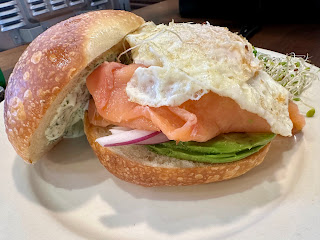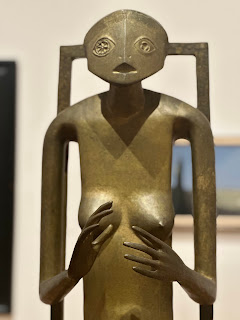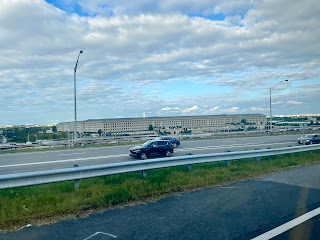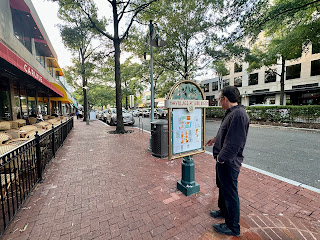THE WHITE HOUSE

We started the day trying to get breakfast with Mr. President, Joe Biden.
I am kidding, obviously, but we did come to visit his home, the White House.
As you can see, we were not invited to come in, but we registered the visit on the other side of the tall gates.
Some regulars use the front of the one of the world's most prestigious home as a stage for their ideas.
I like this guy!
A picture between the gate bars.
I personally liked more the building beside it, connecting to the White House: the Executive Office Building.

My favourite flower making presidents happy too.
Big red hibiscus give the place a bit of colour and warmth with its natural beauty.
I see you and you see me.... cameras everywhere.
There were a few Secret Services agents around, but nothing too flashy.
Over all, it was a quite and not too exciting visit and we were done seeing the White House in 10 minutes.
THE NATIONAL MUSEUM OF AFRICAN AMERICAN HISTORY AND CULTURE
I have been wanting to visit this museum since it opened, while I was working on a series of documentaries about the Transatlantic Slave Trade.
It's an incredible space, as much as it is heavy and sad.
Still, it's an important way to learn and reflect on our sad past and how to work towards reconciliation.
FROM WIKIPEDIA:
https://en.wikipedia.org/wiki/National_Museum_of_African_American_History_and_Culture
The National Museum of African American History and Culture (NMAAHC), colloquially known as the Blacksonian, is a Smithsonian Institution museum located on the National Mall in Washington, D.C., in the United States. It was established in 2003 and opened its permanent home in 2016 with a ceremony led by President Barack Obama.
Powerful entrance already.
Black Lives Matter movement.
Early efforts to establish a federally owned museum featuring African-American history and culture can be traced to 1915 and the National Memorial Association, although the modern push for such an organization did not begin until the 1970s. After years of little success, a legislative push began in 1988 that led to authorization of the museum in 2003. A site was selected in 2006, and a design submitted by Freelon Group/Adjaye Associates/Davis Brody Bond was chosen in 2009. Construction began in 2012 and the museum completed in 2016.


The NMAAHC is the world's largest museum dedicated to African-American history and culture. In 2022 it welcomed 1,092,552 visitors, and was second-most visited Smithsonian Museum, and eighth in the List of most-visited museums in the United States. The museum has more than 40,000 objects in its collection, although only about 3,500 items are on display. The 350,000-square-foot (33,000 m2), 10 story building (five above and five below ground) and its exhibits have won critical praise.
Here is the art that inspired the building where the museum is located.
FROM: https://nmaahc.si.edu/about/building#:~:text=From%20one%20perspective%2C%20the%20building's,Yoruban%20art%20from%20West%20Africa.
From one perspective, the building’s architecture follows classical Greco-Roman form in its use of a base and shaft, topped by a capital or corona. For our Museum, the corona is inspired by the three-tiered crowns used in Yoruban art from West Africa. Moreover, the building’s main entrance is a welcoming porch, which has architectural roots in Africa and throughout the African Diaspora, especially the American South and Caribbean. Finally, by wrapping the entire building in an ornamental bronze-colored metal lattice, Adjaye pays homage to the intricate ironwork crafted by enslaved African Americans in Louisiana, South Carolina, and elsewhere.
The museum covers a large history and culture of African Americans, from artists and people who marked this country through many segments of the society, like the military and power.
This army suit belonged to Colin Powell, US secretary of State (2001-2005).
There are many black athletes contribution, like the boxer Muhammad Ali...
... and basketball player Michael Jordan.
These statues marked on of the most overly political statements in the history of the modern Olympic Games, in 1968, the Black Power salute.
FROM WIKIPEDIA: https://en.wikipedia.org/wiki/1968_Olympics_Black_Power_salute
During their medal ceremony in the Olympic Stadium in Mexico City on October 16, 1968, two African-American athletes, Tommie Smith and John Carlos, each raised a black-gloved fist during the playing of the US national anthem, "The Star-Spangled Banner". While on the podium, Smith and Carlos, who had won gold and bronze medals respectively in the 200-meter running event of the 1968 Summer Olympics, turned to face the US flag and then kept their hands raised until the anthem had finished. In addition, Smith, Carlos, and Australian silver medalist Peter Norman all wore human-rights badges on their jackets.
The contribution of black women is also celebrated in this gallery.
Do you recognize anyone in particular in this picture?
Part of the exhibition shows the history of segregation in schools and how education is a way to make changes happen.
Black pop culture is a huge part of the museum, with African American actors, singers, producers, directors, who made a difference in the US culture scene.
This group of visitors is learning dancing some movements.
This gallery also tells the story of the Green Book - a travel guide book published between 1936 and 1966 that listed hotels, restaurants, bars and gas stations where black travellers would be welcome in the US.
The story became popular on the 2018 film of the same name.

If the higher floors of this museum are about resilience, fight and victories, the basement is about learning how we got here.
The horrible history of the Transatlantic Slave Trade is told in a dark, cold, sad basement, making us imagining the basements of the ships which were used to forcibly bring over Africans to be enslaved in the Americas and Europe.

Chills. It's hard to not feel emotional.
As hard as this history can be, this museum is a necessity... for ALL of us.






I enjoyed very much seeing Rosa Park's dress and Harriet Tubman's Handkerchief.
They are real pieces that belonged to real and brave women.
Walking inside the segregated train car also gave me goose bumps... to imagine what was like for blacks to exist in those hostile environments.
The exhibition ends with victory/hope and looking into the future.
Afternoon "snack" at the museum's cafe: pulled pork, coleslaw and corn bread.
Outside the museum, vendors remind us that change also comes with vote.
NATIONAL GALLERY OF ART
The National Gallery of Art is huge, but we only had time to see the modern and contemporary art.
Amazing place!
Atrium with a big piece of Alexander Calder.
FROM: https://www.nga.gov/collection/artist-info.2047.html
Alexander Calder is perhaps best known for his large, colorful sculpture, which incorporates elements of humor and chance into uniquely engineered structures. Calder was born outside of Philadelphia to a successful, artistic family. His father and grandfather--both named Alexander Calder--were distinguished sculptors and his mother was a portrait painter. Although he initially studied mechanical engineering, receiving a degree from Stevens Institute of Technology, Hoboken, New Jersey, he eventually enrolled in the Art Students League in New York City (1923-1926) and studied painting with John Sloan and George Luks, among others. While working as a graphic artist on assignment at the zoo and circus, Calder discovered his facility for sketching animals. This subject would become a lifelong passion.
Pablo Picasso, Head of a Woman (Fernande)
Wilhelm Lehmbruck, Seated Youth (1917)
Andy Warhol, A Boy for Meg (1962)
Roy Lichtenstein, Painting With Statue of Liberty (1983)
Roni Horn, Opposite of White (2006-2007)
Michelangelo Pistoletto, Donna Che Indica (Woman Who Points- conceived 1962, fabricated 1982)
Piece with tire rubber.
Rooster on the roof.
FROM: https://www.nga.gov/press/2021/fritsch.html
A beloved addition to the East Building's Roof Terrace since it opened in 2016, Katharina Fritsch's Hahn/Cock (2013) will now call the National Gallery of Art, Washington, its permanent roost. The 14-foot-tall sculpture of a blue rooster, an animal often associated with regeneration, awakening, and strength, has been donated to the nation's art museum on its 80th anniversary by Glenstone Museum in honor of the resilience of the American people during the COVID-19 pandemic.
TRIP TO ARLINGTON, VIRGINIA
As if our day was not already packed, we bought tickets to see a play at the SignatureTheatre in Arlington, Virginia, which s basically on the other side of the river.
That gave us the opportunity to check out Washington's subway system, which, by the way, worked fine.
The train comes to the surface at some point and we could see the Pentagon while passing by.
We got off at the Pentagon City station and then got a bus to Shirlington Station, which is a lovely area with restaurants and small shops. That's where the Signature Theatre is located.
We watched a powerful and intimate play called Primary Trust.
The acting was amazing and really moved us.
FROM https://www.sigtheatre.org/
A touching and funny story of finding connection and moving forward that won the 2024 Pulitzer Prize.
Wally’s Tiki Bar serves the sweetest mai tais in town, and Kenneth never misses a happy hour with his best friend. But when a job loss upends Kenneth’s static existence, he must discover the courage to open a new door and change his life – even if it means facing the past and letting go.
A New York Times Critic’s Pick, this DC premiere is a beautiful and tender journey towards new beginnings and seeing the world for the first time.
“It will restore your faith in theatre’s elemental storytelling powers.” – The Observer
One of the cute theatre - The Ark - before the play started.
Here, we ended our cultural day in Washington DC.































































































